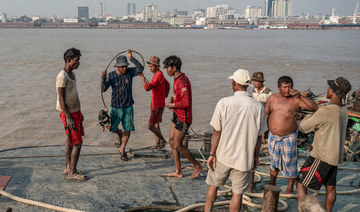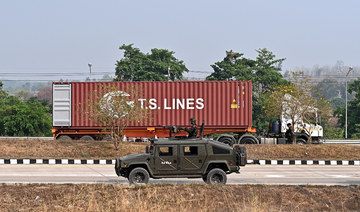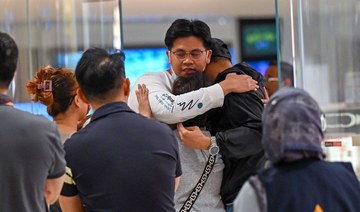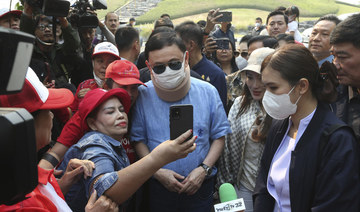BANGKOK: Six months into an offensive against Myanmar ‘s military government, opposition forces have made massive gains, but civilian casualties are rising sharply as regime troops increasingly turn toward scorched-earth tactics in the Southeast Asian country’s bitter civil war.
There is pressure on all fronts from powerful militias drawn from Myanmar’s ethnic minority groups and newer resistance forces. Troops are retaliating with air, naval and artillery strikes on hospitals and other facilities where the opposition could be sheltered or aided.
“When the mass of people rise up against them, I think it terrifies them,” said Dave Eubank, a former US Special Forces soldier who founded the Free Burma Rangers, a humanitarian aid organization that has provided assistance to both combatants and civilians in Myanmar since the 1990s.
“They know that hospitals, churches, schools and monasteries are important places for human care, and gathering, and symbols — and they hammer them,” said Eubank. “That’s new.”
Military forces now control less than half the country, but are holding on tenaciously to much of central Myanmar including the capital, Naypyidaw — recently targeted by drone attacks — and largest city, Yangon, and is far better armed than the resistance forces, with support from Russia and China.
“People have been saying that the regime was on the brink of collapse since two weeks after the coup,” in February 2021, said Morgan Michaels, an analyst with the International Institute of Strategic Studies who runs its Myanmar Conflict Map project.
“On the other hand, obviously the regime is weaker than it’s ever been.... so there’s no doubt that it’s in serious, serious trouble,” he said.
Thet Swe, a spokesman for the military government, denied that troops were targeting buildings and areas where civilians were sheltering, blaming their destruction instead on the opposition forces, without citing evidence.
“The military never harmed hospitals, churches and civilians in our country,” he told The Associated Press in an email. “They did not use that strategy and are fighting the rebels only for the sovereignty of our country.”
As the fighting has moved into more populated areas, about 1 million people have been forced to flee their homes since the start of the offensive in October, contributing to the more than 3 million internally displaced people in the country of some 56 million, according to the UN’s humanitarian aid agency.
With the collapse of its health care system and food supplies dwindling, 18.6 million people are in need, up 1 million from a year ago, including 6 million children, the agency said.
How it began
Opposition in Myanmar, also known as Burma, had been growing since the army seized power from the elected government of Aung San Suu Kyi in February 2021, but it gained new momentum in October when major militias known collectively as the Three Brotherhood Alliance launched a joint offensive.
Together, the Arakan Army, the Myanmar National Democratic Alliance Army and the Ta’ang National Liberation Army — among the most powerful militias formed by Myanmar’s ethnic minorities — made quick advances.
As they captured huge swaths of territory largely in the north and northeast, including economically important border crossings with China and several major military bases, other ethnic armed groups sensed momentum and joined the fighting.
At the same time, People’s Defense Forces — armed resistance groups that support the shadow National Unity Government, which views itself as Myanmar’s legitimate administration — have been increasing in number and launching their own attacks, often supported and trained by the ethnic armed militias.
Both sides claim they have inflicted heavy tolls. And the military government under Senior Gen. Min Aung Hlaing has acknowledged it is under pressure, recently reintroducing conscription to increase its ranks.
That has pushed some young people into the resistance. Many more have fled to rural areas or neighboring countries to avoid fighting.
With the violence across its border, China helped broker a ceasefire in Myanmar’s north in January with the Three Brotherhood Alliance. But the alliance’s Arakan Army continues to fight in its home Rakhine state in the west and has made significant gains, while PDFs and other ethnic armed groups continue their own attacks elsewhere.
The latest fighting
The fiercest fighting in recent weeks has been in the southeast, where the main ethnic Karen fighting force, the Karen National Liberation Army, claimed in early April to have seized all the military bases in Myawaddy, the main town on the border with Thailand in Kayin state, also known as Karen state.
One army battalion clung to a position beside one of Myawaddy’s two bridges, assisted by the Border Guard Force, a rival Karen group that had been in charge of border area security for years, conducting lucrative business by providing protection to area casino resorts with links to organized crime.
The force, which declared itself neutral in January, now controls the town with military government administrators still in place, highlighting how some militia groups still prioritize their own interests.
“This is not a black and white situation. This is not the regime reconquering and reconsolidating control,” Michaels said of the fighting in the area. “This is the regime hanging on, keeping a foothold by the razor’s edge.”
Meanwhile, the military has pushed KNLA and People’s Defense Forces out of Kawkareik, a strategically important town along the road that connects Myawaddy with the rest of the country.
Thousands of civilians have fled Myawaddy and Kawkareik. But many civilians haven’t managed to escape.
At least 1,015 civilian deaths have been documented from Nov. 1 through May 1, according to the Assistance Association for Political Prisoners, a watchdog group that tracks political arrests, attacks and casualties. It says 4,962 civilians have been killed overall since the military took power three years ago.
The watchdog blamed the deaths on the military’s increasing use of scorched-earth tactics and fighting moving into more populated areas.
“The military has increasingly lost areas of control in recent months, which has only increased their use of this strategy, responding with airstrikes, shelling and so on in civilian areas,” the AAPP said in an email.
The group added that the number of civilian deaths in the recent months of fighting is likely double what it reported, if not more, but that it can’t document the numbers due to the intensification of the conflict.
Kyaw Zaw, a spokesperson for the shadow National Unity Government, said the military had destroyed 343 hospitals and clinics since it took power, and that those attacks had accelerated in the last two months, though he didn’t have specific details.
Eubank, with the Free Burma Rangers, said he and his teams operating near the front lines have witnessed the military, known as the Tatmadaw, fighting with a ” speed and force and a viciousness that we’ve never seen.”
But in fighting a common enemy, the resistance is showing growing unity, he said.
“The Burma army is still stronger than any of these resistance groups, and if they want to bring a division or two to bear, they will win the battle, but they’re not stronger than everybody else together,” he said.
What comes next
Whether that unity will continue if the regime falls, and if the disparate resistance forces can agree on a common path ahead for Myanmar, is an open question, Michaels said.
“On one hand, Myanmar is not Syria — there is common cause in fighting the regime,” Michaels said. “But at the same time, as the regime has receded from some areas, there are at least indicators of potential future conflicts between groups.”
He noted an incident in northern Shan state last month in which troops from two members of the Three Brotherhood Alliance — the Myanmar National Democratic Alliance Army and the Ta’ang National Liberation Army — traded fire over a territorial dispute. One person was injured.
The groups quickly agreed to stand down, but the incident illustrates that territorial tension is real, Michaels said.
An opposition politician still inside the country, speaking on condition of anonymity for his own safety, said Myanmar’s people have a common desire for peace and stability, but the various factions still pursue their own interests.
“It is hard to predict what is ahead, and they still don’t have a single political direction or goal. I think there is quite a problem in this situation,” he said.
“Myanmar is now at a crossroads.”
Civilian casualties rise in Myanmar’s civil war as resistance forces tighten noose around military
https://arab.news/8m8as
Civilian casualties rise in Myanmar’s civil war as resistance forces tighten noose around military
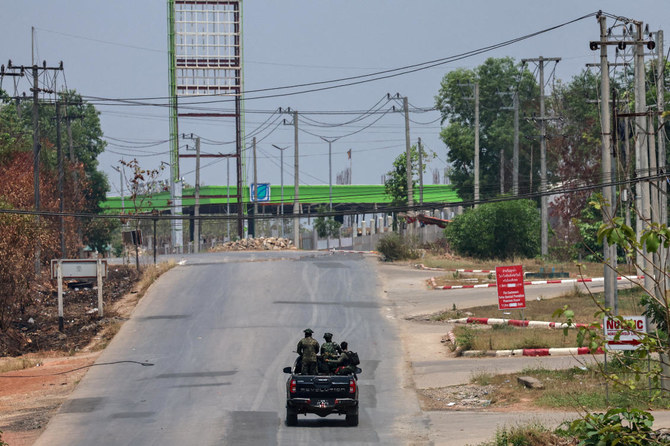
- An estimated one-third of those displaced are children, according to the UN statement
UK police arrest 40 after pro-Palestinian rally

- Individuals were arrested late on Tuesday for offenses including breaching public order conditions, obstructing roads and assaulting emergency workers
London: UK police on Wednesday said that 40 people had been arrested and three officers injured after protesters refused to disperse following a demonstration in London over Israel’s latest offensive in Gaza.
The British capital’s Metropolitan Police Service said the individuals were arrested late on Tuesday for offenses including breaching public order conditions, obstructing roads and assaulting emergency workers.
It said two officers sustained minor injuries after being assaulted while a third, who was struck by a bottle thrown from within the crowd, suffered a “serious facial injury.”
The Met, as the force is widely known, said an investigation was under way to identify who threw the bottle.
Police had approved plans for the early evening protest — organized by a coalition including the Palestine Solidarity Campaign — outside the gates of Downing Street in central London.
But it imposed conditions including that the rally end by 8:00pm.
Up to 10,000 people attended, and the “vast majority” had left by the required time, but a group of around 500 remained to continue protesting, according to police.
“Officers engaged extensively before making a number of arrests for failing to comply with conditions,” the Met said in a statement.
“As they moved in, some in the crowd resisted physically requiring officers to use force to extract those who had been arrested.”
Further arrests followed later in the evening after the remaining demonstrators launched a breakaway march and were eventually corralled outside a train station, the Met said.
Israel’s renewed military operations in Gaza, concentrated on Rafah, have sparked fresh protests in London and other cities around the world.
The British capital has seen frequent marches protesting Israel’s response to the deadly Hamas attack on its territory on October 7, stoking controversy and political debate over how they should be policed.
They have passed off largely peacefully, but police have made arrests at many for various offenses, including anti-Semitic chanting and banners, promoting a proscribed organization and assaults.
Singapore Airlines flight investigation finds sharp altitude drop caused injuries

- One passenger died of a suspected heart attack and dozens were injured after Flight SQ321 encountered extreme turbulence
SINGAPORE: Preliminary findings of an investigation into a Singapore Airlines flight hit by severe turbulence last week showed a rapid change in gravitational force and a 54 meter altitude drop caused injuries, Singapore’s transport ministry said on Wednesday.
One passenger died of a suspected heart attack and dozens were injured after Singapore Airline Flight SQ321, flying from London to Singapore, encountered what the airline described as sudden, extreme turbulence while flying over Myanmar. The ministry said the investigation was ongoing.
The SQ321 London-Singapore flight on a Boeing 777-300ER plane carrying 211 passengers and 18 crew diverted to Bangkok for an emergency landing after the plane was buffeted by turbulence that flung passengers and crew around the cabin, slamming some into the ceiling.
“The aircraft experienced a rapid change in G (gravitational force) ... This likely resulted in the occupants who were not belted up to become airborne,” the ministry said in a statement, citing a report by the Transport Safety Investigation Bureau of Singapore.
“The vertical acceleration changed from negative 1.5G to positive 1.5G within 4 seconds. This likely resulted in the occupants who were airborne to fall back down.
“The rapid changes in G over the 4.6 seconds duration resulted in an altitude drop of 178 ft (54 m), from 37,362 ft to 37,184 ft. This sequence of events likely caused the injuries to the crew and passengers,” it said.
The report also said a pilot was heard calling out that the fasten seat belt sign had been switched on.
Aid reaches Papua New Guinea landslide site

- Difficulties getting aid and supplies to the site has stoked a mix of desperation and frustration on the ground
- Full-scale rescue and relief efforts have been severely hampered by the site’s remote location
PORT MORESBY: Supplies of food and medicine began arriving at the scene of a deadly landslide in Papua New Guinea Wednesday, with aid workers discovering children rendered mute by the shock of the disaster.
Papua New Guinea’s government estimates that as many as 2,000 people may be buried underneath a massive landslide that struck a thriving highland settlement in Enga province in the early hours of May 24.
Only six bodies have so far been pulled from the mountain of churned-up earth after days of frantic digging with makeshift tools.
Difficulties getting aid and supplies to the site — and the speed of the government response — has stoked a mix of desperation and frustration on the ground.
Community leader Miok Michael said that 19 of his “family members and relatives” were missing and feared dead.
“The relief support and donations are slowly reaching the affected site,” said Michael, who recently visited the disaster zone.
“But displaced people are still crying and calling for help. There is no proper house for them to sleep, all their houses were buried.”
With rescue teams abandoning hope of finding survivors under the meters of mud and rubble, the community has started to count the emotional and physical cost.
Mourning locals have started carrying the dead away in immense “haus krai” funeral processions, collective outpourings of love and grief that can last for weeks.
Images showed a group of men carrying a wooden casket down the forested valley on their shoulders as scores of mourners trailed behind them, wailing with despair.
Aid groups fear children will bear the brunt of the catastrophe, estimating that 40 percent of residents in the area are younger than 16.
“What we are hearing is that, because of what they saw and experienced, many of the children have stopped talking,” Justine McMahon from CARE Papua New Guinea said.
Niels Kraaier from UNICEF Papua New Guinea said workers were aware of nine orphaned children.
UNICEF said it had started distributing rudimentary hygiene kits of buckets, jerrycans and soap, while World Vision said food, shelter, blankets and mosquito nets remained immediate needs.
However, full-scale rescue and relief efforts have been severely hampered by the site’s remote location, nearby tribal violence and landslide damage that has severed major road links.
The collapse of bridges along the sealed road to the site has forced lengthy detours for some aid convoys.
Papua New Guinea’s military tried for days to bring heavy earth-moving equipment to the site.
But, with a series of bridges in a state of disrepair or damaged by earlier floods, they have now abandoned that plan and will source equipment from mines and businesses.
That equipment will arrive at the landslide by Thursday at the “latest,” UN migration agency official Serhan Aktoprak said.
Provincial leaders have implored the government to declare a national emergency that would draw attention to their plight and free up resources.
“I am not equipped to deal with this tragedy,” provincial administrator Sandis Tsaka said.
Prime Minister James Marape is yet to visit the remote pocket of Enga province more than five days after the landslide.
He has stayed in the capital Port Moresby, where his government is trying to fend off a no-confidence motion that could sweep it from power.
There are concerns this political manoeuvering has drawn attention away from what could be one of the country’s worst natural disasters.
Marape told parliament on Wednesday that the village of Yambali was “no more.”
“Nature, through a disastrous landslip, submerged or covered the village and from our initial estimation over 2,000 people would have perished in this disaster.”
“In this year, we have had extraordinary rainfall that has caused flooding in river areas, sea level rise in coastal areas, and landslips in a few areas,” Marape said.
Papua New Guinea is one of the world’s most disaster-prone regions and landslides are extremely common in its highlands.
Geologists believe recent heavy rain may have contributed to the slide.
“Papua New Guinea sits right on a plate boundary, where these large, rigid parts of the earth plow into each other,” University of Adelaide geologist Alan Collins said.
“This creates mountains, steep slopes and other extreme topography.
“You have these steep slopes located in an area of heavy rainfall, and this can rot the minerals in the rocks, and gradually weaken them.”
The World Bank and others have warned that landslides were likely to increase in Papua New Guinea due to a growing population and uncontrolled land use.
Scientists have also warned that climate change will cause more extreme rainfall across most parts of the world.
China hosts Arab leaders at forum aimed at deepening ties

- Beijing has sought to build closer ties with Arab states in recent years
- Last year it brokered a detente between Iran and Saudi Arabia
BEIJING: China on Wednesday hosts a litany of Arab dignitaries and diplomats ahead of a forum Beijing hopes will deepen ties with the region and present a “common voice” on the conflict between Israel and Hamas.
Beijing has sought to build closer ties with Arab states in recent years, and last year brokered a detente between Tehran and its long-time foe Saudi Arabia.
It has also historically been sympathetic to the Palestinian cause and supportive of a two-state solution to the Israeli-Palestinian conflict.
And Beijing last month hosted rival Palestinian groups Hamas and Fatah for “in-depth and candid talks on promoting intra-Palestinian reconciliation.”
Egypt’s President Abdel Fattah El-Sisi and UAE President Sheikh Mohamed bin Zayed Al-Nahyan, as well as a host of other regional leaders and diplomats, are among the delegates attending the forum.
President Xi Jinping is set to deliver a keynote speech at the opening ceremony on Thursday, Beijing has said, aimed at building “common consensus” between China and Arab states.
Top of the agenda will be the war between Israel and Hamas, which Xi has called for an “international peace conference” to resolve.
China sees a “strategic opportunity to boost its reputation and standing in the Arab world” by framing its efforts to end that conflict against US inaction, Ahmed Aboudouh, an associate fellow with the Chatham House Middle East and North Africa Programme, said.
“This, in turn, serves Beijing’s focus on undermining the US’s credibility and influence in the region,” he said.
“The longer the war, the easier for China to pursue this objective,” he added.
On Tuesday, Foreign Minister Wang Yi met with counterparts from Yemen and Sudan in Beijing, saying he hoped to “strengthen solidarity and coordination” with the Arab world.
He also raised China’s concerns over disruptive attacks on Red Sea shipping by Iran-backed Houthi forces acting in solidarity with Hamas with his Yemeni counterpart Shayea Mohsen Al-Zindani.
“China calls for an end to the harassment of civilian vessels and to ensure the safety of waterways in the Red Sea,” state news agency Xinhua quoted him as saying.
Former Thai Prime Minister Thaksin Shinawatra to face trial for royal insult

- The former prime minister will also be indicted for violating the Computer Crime Act
- Thaksin had been in self-imposed exile since 2008, but returned to Thailand in August last year
BANGKOK: Thai prosecutors said Wednesday former Prime Minister Thaksin Shinawatra will be indicted for defaming the monarchy, three months after he was freed on parole on other charges.
Thaksin will not yet be indicted because he had filed a request to postpone his original appointment on Wednesday with proof that he has COVID-19, Prayuth Bejraguna, a spokesperson for the Office of the Attorney General, said at a news conference.
The attorney general’s office scheduled a new appointment for Thaksin’s indictment on June 18, Prayuth said, adding that Thaksin will also be indicted for violating the Computer Crime Act.
Thaksin had been in self-imposed exile since 2008, but returned to Thailand in August last year to begin serving an eight-year sentence. He was released on parole in February from the hospital in Bangkok where he spent six months serving time for corruption-related offenses.
On his return, he was moved almost immediately from prison to the hospital on grounds of ill health, and about a week after that King Maha Vajiralongkorn reduced his sentence to a single year. Thaksin was granted parole because of his age — he is 74 — and ill health, leaving him free for the remainder of his one-year sentence.
His return was interpreted as part of a political bargain between his Pheu Thai Party and the conservative establishment — longstanding rivals — to stop the progressive Move Forward Party from forming a government following its victory in last year’s general election.
After his return, the attorney general’s office said it had revived an investigation into whether Thaksin almost nine years ago violated the law against defaming the monarch, a crime punishable by up to 15 years in prison.
Thaksin was originally charged in 2016 with violating the law for remarks he made to journalists when he was in Seoul, South Korea, a year before that, but the investigation could proceed only after he was presented with the charge in person in the hospital in January, officials said. Thaksin had denied the charges and submitted a statement defending himself.
Prosecutor’s spokesperson Prayuth said there is enough evidence for the attorney general to indict Thaksin. He said the prosecutors have already prepared their statement and documents to present to the court next month.
Since his release, Thaksin has maintained a high profile and is believed to be wielding influence in the government led by Prime Minister Srettha Thavisin. One analyst believes Thaksin’s growing influence has angered the ultra-conservatives and that the indictment is their response.
“It is designed to keep Thaksin under control. This is keeping him on a leash. If he doesn’t behave then this charge can be activated and could land him in jail. This is to curtail his movement and his maneuvers and to remind him, sending him a signal in a way, to know who’s in charge and to know he should not overstep the boundary,” said Thitinan Pongsudhirak, at professor at Bangkok’s Chulalongkorn University.



